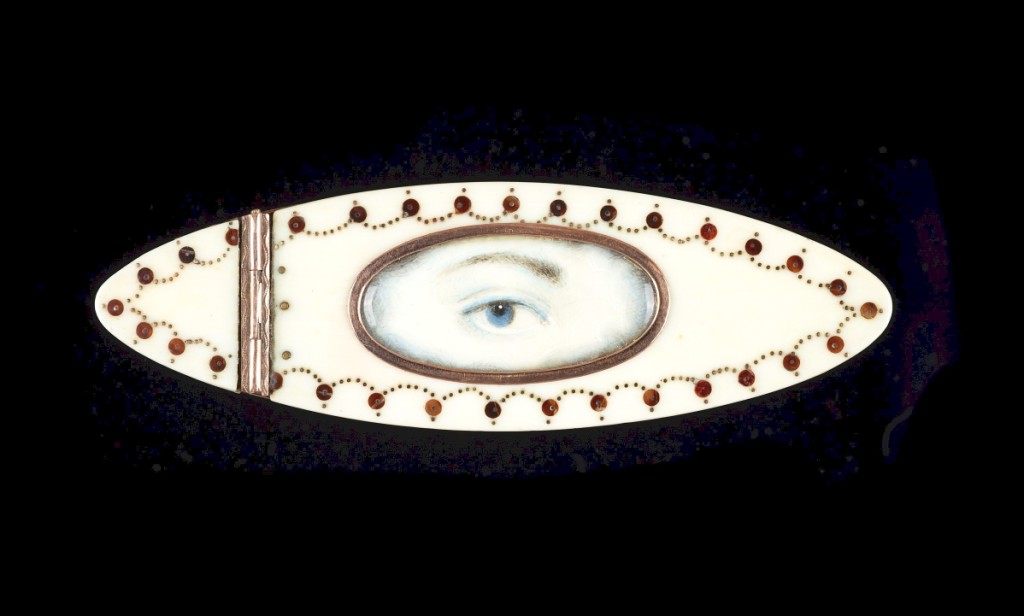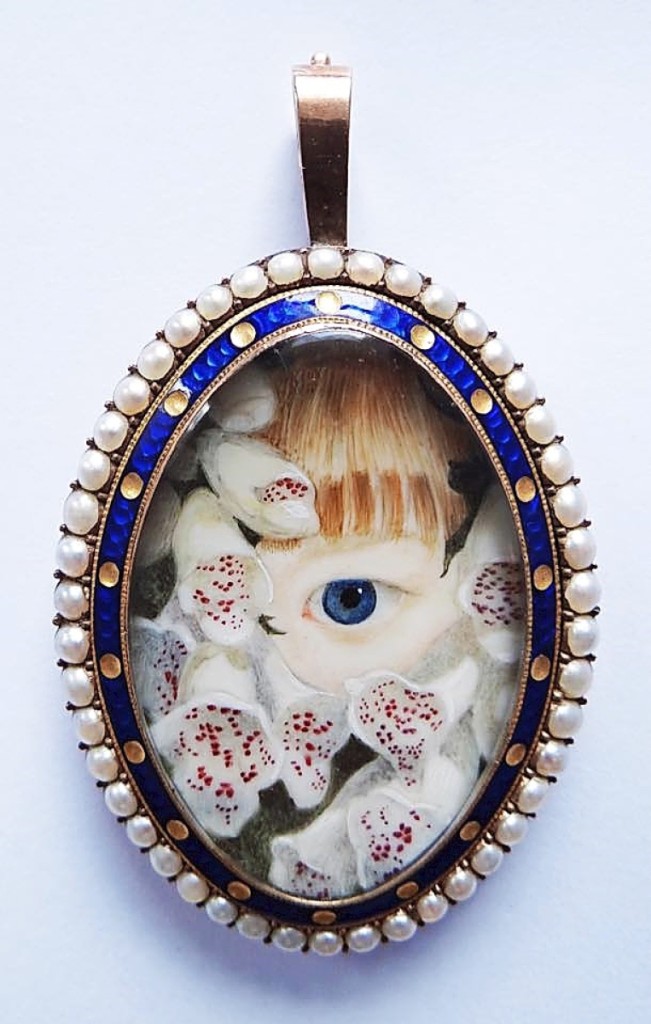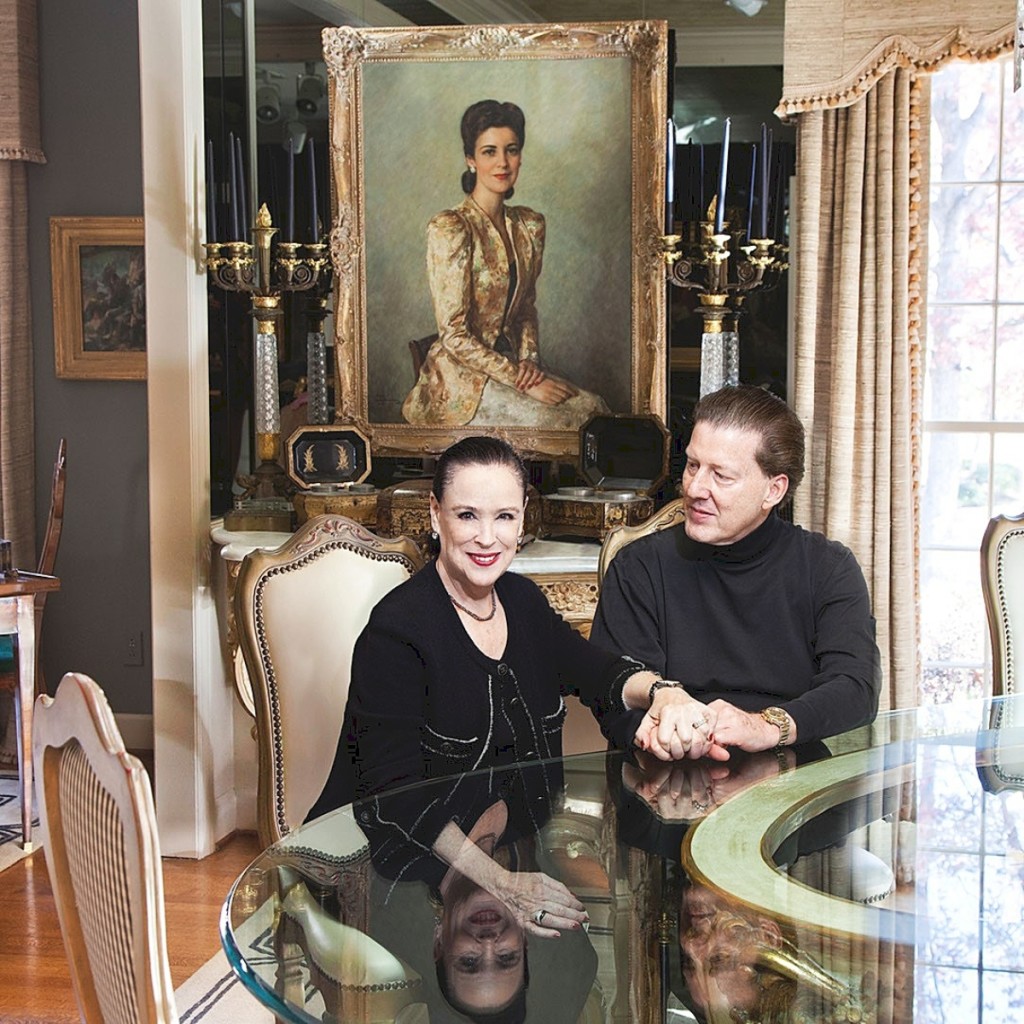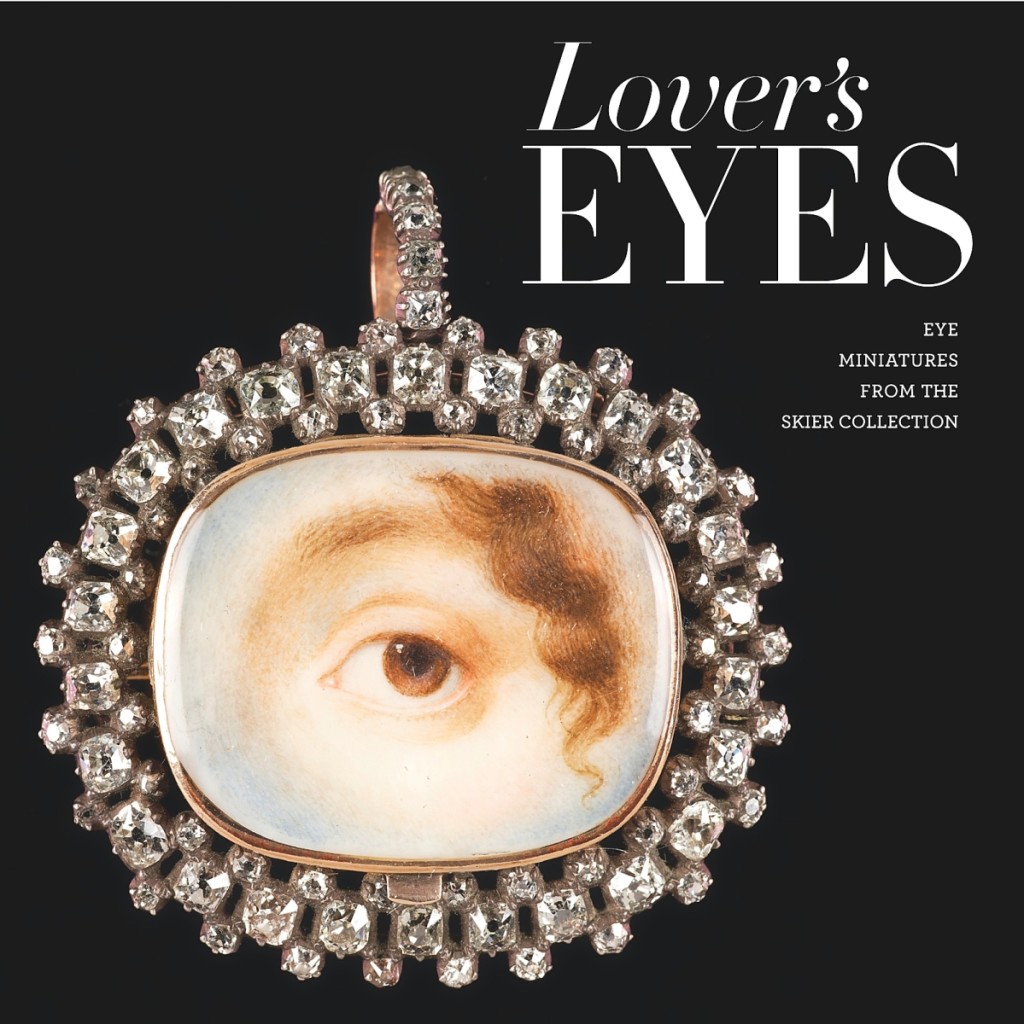Books on portrait miniatures do not come out that often. When word spread that eye miniature collectors Nan and David Skier were publishing Lover’s Eyes: Eye Miniatures from the Skier Collection, a follow-up book to their 2012 book, The Look of Love: Eye Miniatures from the Skier Collection, we reached out for a sneak peek at what’s behind their collection, how they’ve cultivated their own eye for these tiny treasures, and what insights the new book shares.
How did you start collecting eye miniatures?
DS: It started a long time ago. I’m an ophthalmologist and we’ve always been interested in antiques: tea caddies, English calling card cases, etc. We were at a medical meeting in Boston in the 1980s and we went to the Cyclorama Antique show. We came to Edith Weber’s booth, which specialized in antique jewelry. Nan has some fabulous antique jewelry, and we were looking around and – I can still remember it – there was this gorgeous ring, surrounded by diamonds and blue enamel, guilloche, which contained the image of a single eye. A young man – it was Barry Weber – came over and asked if he could help us. We asked him about the ring, and he said, ‘that’s an eye miniature or lover’s eye. Do you know anything about them?’ We knew nothing about them, so he went into the story. Not only was the image beautiful and intricate and delicate but it was in wonderful pristine condition; we said, ‘we have to have that.’
What was it about that one that captivated you?
NS: Although David is an ophthalmologist, what really captivated us was its beauty, its significance, its secret story, its age and rarity. That eye ring is now example number one in our book.
What did you learn from him, what advice did he give you?
DS: Barry told us that eye miniatures were a way to exchange a gift with a secret lover. Looking at that single disembodied eye, it was hard – if not impossible – to guess the identity of the sitter. We consulted with Barry often over the years before his death in 2010, but we will never forget the warning he gave us at that first meeting – ‘this ring is made of watercolor painted on ivory, so please do not wash your hands while you are wearing it.’
Are there fakes on the market?
NS: Portrait miniature dealer and our friend Elle Shushan, who edited our new book, Lover’s Eyes: Eye Miniatures from the Skier Collection, says that 98-99 percent of eye miniatures currently on the market are either fake or fashion, but not actual life portraits of eyes.
How are they faked?
DS: People buy antique miniature surrounds, which are easy to find, and they can cut down a period portrait miniature, or even insert a newly painted eye image.
When were these popular?
NS: These were first popular when George III was King of England. His son, who became King George IV, fell in love with Maria Fitzherbert, a twice widowed commoner and a Catholic. Since they could not legally marry because of her religion, they arranged a secret, morganatic marriage without the blessing of the King. This ‘left-handed’ marriage could not be officially recognized. He and Maria exchanged eye miniatures; the one he gave her is with her family, the one she gave him was buried with him.
Were these a singularly English tradition?
NS: There may have been some French eye miniatures that preceded this, but most are British.
Why is that?
DS: These are so small; most are not signed by the artist. Unless there is an engraving on the back or other identifier, it’s very hard to know where they are from or who the artist might have been. We own more than 130 eye miniatures and we have determined the identities of only five. What is so alluring about them is that they are so mysterious. They were supposed to be anonymous.
Did all miniature painters paint eye miniatures?
NS: No, most miniature portrait painters did not paint eye miniatures. Richard Cosway and George Engleheart were some of the most well-known painters of eye miniatures, largely because they both kept really good records.
DS: What’s interesting about Cosway – and there’s an essay on Cosway in the new book – is that George IV was a notorious gambler and never paid his bills to Cosway.
What was the most important thing you’ve learned over the course of your collecting?
DS: What’s important to learn is the connoisseurship. To read everything you can, to talk to people, to examine what you have and to develop a keen eye so you will understand the pieces as you look at them.
NS: Quality and condition are critical factors for us. We’ve been offered many and we want them in pristine condition.
Has your collecting evolved over time? How?
DS: We’ve always bought the best we could, but it’s evolved. We want things to be right. Eye miniatures come in so many forms – rings, brooches, bracelets, necklaces, boxes, even cufflinks, that we want to have examples of many kinds. As we collect, we want the more special and rare pieces… We want only the really great ones, the ones that will get us someplace. If we see a similar form that’s better than one we already have and it has good provenance, we’ll buy it.

Ivory toothpick case with gold piqué embellishment, hinged lid and burgundy velvet interior, circa 1890, lady’s blue right eye with blue and gray clouds at the edges. Dimensions: by 15/16 by 5/16 inches.
Is your complete collection?
NS: As long as we are alive, it will never be complete. We love looking for these together and are always on the hunt. People who know us will let us know if they see a piece they think we’d like.
Do you always agree on what to buy?
DS: Almost always. Things have to really appeal to or ‘zing’ us. We also have a ‘two-out-of-three’ rule when it comes to buying things. We work with an advisor for the artwork we buy – Elle is our advisor on miniatures; we have another advisor for the American Ashcan School paintings we buy – two of the three of us have to agree it’s worthy.
What does the new book discuss that the first one did not?
NS: We’ve learned a great deal in the past nine years which we have incorporated in the new volume, adding to essays, adjusting descriptions and providing recently discovered information.
There are four new essays. Graham Boettcher, director of the Birmingham Museum of Art, has written a wonderful piece about the artists painting eyes in the Twentieth and Twenty-First centuries, including such oddities as the ceiling in Blenheim Palace, where Gladys, Duchess of Marlborough commissioned her eyes and the Duke’s to be painted. Additionally, Graham’s essay profiles the artists painting eyes today.
Elle Shushan has delineated the much-asked question “Fake or Fashion,” illustrating why one piece may be considered fashion and another was made to deceive. In another essay Elle examines the rare and wonderful “flower eyes” of which only six are known, with one in our collection.
We are pleased to have Dr Stephen Lloyd, the acknowledged expert on Richard Cosway, R.A., to explain and illustrate the most notorious of eye portraits – those painted by Cosway for the Prince of Wales and Mrs Fitzherbert.

Eye of Mary Sarah Fox, enveloped in foxgloves, set in a gold frame with seed pearl and guilloche border, circa 1835.
What has been your most recent eye miniature acquisition?
DS: Elle gave us as a gift a portrait miniature in which the sitter was wearing an eye miniature. It’s the only one she’s ever seen, the only one we’ve ever seen. That’s the most recent addition to our collection.
Do you collect portrait miniatures?
DS: We only have a few, which relate in some way to our eye miniature collection.
Do your children and grandchildren appreciate your collection? Do they share your interest?
NS: We’ve explained the value and rarity to our children so they can make an informed decision as to what they do with the collection when it becomes theirs. We’re doing this – collecting, creating the books and putting on the exhibitions – for our own pleasure and enjoyment
The first book was published in conjunction with an exhibition at the Birmingham Museum of Art. Do you have plans to have another exhibition in conjunction with this new book?
DS: Not right now. We’ve been very, very careful during the pandemic. The eye miniatures are very fragile so conditions for exhibiting them have to be very specific. For “The Look of Love,” exhibition, which originated at the Birmingham Museum of Art in Birmingham, Ala., and traveled to the Georgia Museum of Art, Winterthur and the Minneapolis Institute of Art, the collection was lighted by recessed fiber optic light cables and each exhibition case was sealed and climate controlled.
NS: All of the eye miniatures in the “Look of Love” exhibition were also shown on iPads, which allowed the visitors to enlarge, flip and rotate the objects, and to see them open and closed. At the time, this technology was revolutionary and really brought the objects to life.
DS: We are amazed at how wide our audience has been. We get frequent requests to use images of the eyes. A Norwegian rock ‘n’ roll band put some of our eyes on the cover of their album. If it’s a legitimate and reputable request, we consider it.
-Madelia Hickman Ring






